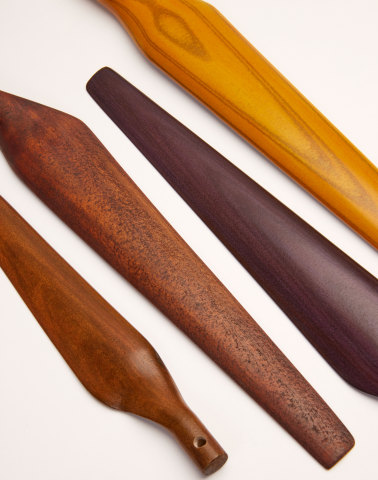Financial News
Desktop Metal Develops New Additive Manufacturing Process for Volume Production of Sustainable, End-Use Wood Parts
Forust Is the World’s First Manufacturer to Use Additive Manufacturing to Upcycle Wood Byproducts for the Production of Custom and Luxury Wood Products
- Architect and author William McDonough, a globally-recognized leader in sustainable development and design, hails the Forust process as a true embodiment of Cradle to Cradle manufacturing philosophy
- Swiss industrial designer Yves Béhar, founder of fuseproject, is the first to design an exclusive collection of home goods for production using the Forust process, now available for purchase on www.forust.com
- Desktop Metal’s new Forust additive manufacturing process upcycles wood waste from the approximately 15 billion trees cut down each year1 into luxurious, high-quality, end-use wood parts that can be used in a variety of industries, from consumer goods and furniture to home goods and automotive luxury interiors
Desktop Metal (NYSE: DM), a leader in mass production additive manufacturing (AM) solutions, today announced the launch of Forust™, a new process to sustainably produce functional end-use wood parts using its patented single pass binder jetting AM technology. The Forust process upcycles waste byproducts from wood manufacturing (cellulose dust) and the paper industry (lignin) and re-materializes functional wood parts through high-speed 3D printing including digital grain throughout the part.
This press release features multimedia. View the full release here: https://www.businesswire.com/news/home/20210506005551/en/

Forust is the world’s first manufacturing process to use additive manufacturing to upcycle wood byproducts for the production of custom and luxury wood designs. Unlike particle board or laminate, Forust produces a wooden part with a digital grain that flows throughout the entire part which can then be sanded or finished. Software has the ability to digitally reproduce nearly any wooden grain, including rosewood, ash, zebrine, ebony and mahogany. (Photo: Business Wire)
Desktop Metal’s high-speed 3D printing technology offers architects, designers and manufacturers a new path to produce luxurious custom wood pieces for home decor, interiors, transportation, and architectural design with a superior environmental footprint, new geometries and quality unavailable from subtractive wood manufacturing technology. Starting today, businesses and consumers can visit the Forust website, www.forust.com, to order samples and custom wood designs, and manufacturers can engage with Forust to develop unique wood parts for their end-use products.
According to William McDonough, architect, globally-recognized leader in sustainable development and design, and pioneer of the concepts of Cradle to Cradle, the Circular Economy, and the Circular Carbon Economy, “The Forust technology allows us to take something that was previously wood waste and re-materialize it into exquisitely beautiful and useful things. We are honoring the cellulose and lignin of the trees by rearticulating them into assets for present and future generations. By allowing millions of trees to remain in place in their forests, Forust is launching a highly evolved technology for the circular technosphere that supports and celebrates stewardship of the natural, regenerative, and diverse biosphere, making it not only smart, but wise. This is a historic and material opportunity in the history of design and the making of things that reminds me of Arthur C. Clarke’s famous quote, ‘Any technology that is sufficiently advanced is indistinguishable from magic.’ As a lover of wood and forests, I find Forust indistinguishable from magic. The 3D printing of wood using waste natural materials is a gamechanger. We have only begun to explore its beneficial potentials, but it is clear they are immense.”
Transforming a Subtractive Industry That Began with Trees into an Additive Industry That Begins with Upcycled Wood Byproducts
Forust began with a vision to transform wood byproducts, including sawdust and lignin, into finished wood products, combining both stunning design and functionality. Led by industry veteran and ceramics 3D printing pioneer, Andrew Jeffery, who previously served as President of Boston Ceramics, the Forust team brings decades of collective experience in additive manufacturing, materials research, and computer aided design to solve the challenge of sustainability in finished wood parts. Jeffery is joined by co-inventors and creative consultants in industrial design, Virginia San Fratello, Chair of the Department of Design at San Jose State University, and Ronald Rael, Professor and Chair of the Department of Architecture at the University of California Berkeley, both of whom are also founding partners of 3D printing company, Emerging Objects.
“The inspiration for Forust was to begin with sawdust and end with forests,” said Jeffery. “Our process is based on extensive research conducted over the past decade in the field of hardwood lumber, leading to complex and elegant finished structures. Through advanced CAD software, proprietary materials and Desktop Metal binder jetting mass production platforms, we can now manufacture beautiful, functional and innovative wood products for a variety of architectural, interior, and home goods applications from upcycled wood byproducts.”
Building a Greener Future with Additive Manufacturing for Wood
At the core of this innovation is the Forust process, which combines two waste streams from traditional wood production, sawdust and lignin, to sustainably produce isotropic, high-strength wood parts. Depending on the size of the parts, Forust can manufacture wood products using either the Shop SystemTM or a custom version of the new RAM 336TM 3D printer, which supports prints up to two cubic meters in volume at speeds in excess of 100 liters of parts per hour. During the printing process, layers of specially treated sawdust are spread and selectively joined by a non-toxic and biodegradable binder. Digital grain is printed on every layer and parts can then be sanded, stained, polished, dyed, coated and refinished in the same manner as traditionally manufactured wood components.
“Forust offers nearly unlimited design flexibility,” said Jeffery. “From exotic grain structures to grainless wood, we can digitally reproduce wood textures and a myriad of grain types. And, because they are made from a wood and bioresin compound, these parts exhibit the functionality and stiffness in line with conventional wood. Our finished pieces are indistinguishable from traditionally manufactured wood products you would find in a store. The additive manufacturing process literally becomes invisible.”
Forust is set to revolutionize volume production of wood parts through a completely digital manufacturing process:
-
Streamlined Production of Complex Wood Designs
Because Forust produces parts additively layer by layer without the need for supports, designers have the freedom to create complex features and iconic designs that would be difficult or impossible to produce with traditional woodworking methods.
-
High-Quality Materials and Finishes
Unlike particle board or laminate, Forust produces a wooden part with a digital grain that flows throughout the entire part that can be sanded and refinished. Software has the ability to digitally reproduce nearly any wood grain, including rosewood, ash, zebrano, ebony and mahogany, among others. Parts will also support a variety of wood stains at launch, including natural, oak, ash, and walnut.
-
Cost-Effective Carbon Footprint Reduction with On-Demand Manufacturing
Forust’s process and materials are designed to offer easy access to an end-to-end sustainable manufacturing solution. Manufacturers and designers can submit their own custom designs for printing, order samples or pursue high-volume partnerships to produce custom, 3D printed wood pieces in volume for use in their products. Additive manufacturing enables digital on-demand production, which minimizes material waste, on-the-shelf inventory, and shipping pollution while offering hand-crafted quality at an accessible price.
“We want to make it easy for designers to explore complex new geometries for a wide variety of products and applications using an age-old material,” said Jeffery. “At the end of the wood product’s life, we would like to see customers have two choices - dispose of it and it will biodegrade over time as any wood product would, or shred it and repurpose the material into future parts through Forust. Our vision is a true circular manufacturing process.”
Unlimited Design Applications for Wood Parts, Including Exclusive Collection by Designer Yves Béhar
The global finished wood products market is expected to reach $1.8 trillion by 20272. From everyday home goods to high-end, architectural detailing, Forust can create functional parts for virtually any wood application with a greatly improved environmental footprint than conventional manufacturing. Architects, interior and industrial designers, manufacturers and even consumers can visit www.forust.com to upload and order custom designed wood pieces, such as:
- Architectural accents, including one-of-a-kind decorative panels, custom wood inlays and panels, tiles, hardware and more;
- Luxury interior components in a wide range of finishes and materials, including rare and exotic grain structures, for vehicles, yachts and high-end homes;
- Furniture pieces, including cabinetry doors, chairs, accents, tables and designs with 3D geometry previously difficult or impossible to manufacture through conventional woodworking methods; and
- Home goods products ranging from flowerpots, bowls and picture frames, to textured blocks, bathroom accessories, desk accessories, sculptures, tiles and more.
An array of consumer home goods pieces designed by Forust and others in collaboration with talented independent designers and brands, is now available for purchase at www.forust.com/store. Among the first designer products available on the Forust webstore is a collection created by industrial designer and founder of fuseproject, Yves Béhar. The Vine collection, which includes a vessel, bowl, basket, and tray, honors the warmth and familiarity of the wood material with curving, organic forms that extrude from a singular point and twist up into a repeating pattern.
“As a designer, I use a lot of wood and being able to use a product made from sawdust and lignin is an amazing resource,” said Béhar. “The future of design and production really hinges on new technologies coming on and allowing designers to approach materials and manufacturing in ways that are sustainable, in ways that are low carbon footprint, in ways that we are using waste instead of cutting down more trees or extracting more oil out of the soil. Design isn’t just something that remains the same all the time. This new technology allows us to really address some of the critical problems around the environment and global warming that we are facing.”
“Applications for Forust’s wood parts are really limitless,” said Ric Fulop, Founder and CEO of Desktop Metal. “There are many applications where polymers and plastics are used today where you can now cost-effectively replace with sustainably manufactured wood parts – luxurious, high-end components in interiors, consumer electronics, instruments, aviation, boats, home goods and eventually in flooring and exterior roofing applications. For the first time, we can produce beautiful parts with the same durability and characteristics you would have in traditionally manufactured wood, but printed using upcycled materials which does not require cutting down or harvesting trees. With Forust, we have the opportunity to have a meaningful impact on sustainability, climate change and waste issues that we as a humanity have brought to the planet. For each tree saved, we are reducing the carbon footprint by a metric ton over its lifetime.”
About Forust
Forust™, a wholly-owned subsidiary of Desktop Metal, makes high-volume additive manufacturing of end-use wood parts possible with stunning designs that are affordable and sustainable. The Forust process applies the speed, precision and quality of binder jet additive manufacturing technology to produce strong, lightweight wood parts created from wood waste streams such as wood sawdust and lignin. The mission is to develop responsible material value chains that are critical to achieving net-zero carbon emissions and building a sustainable future. Led by industry veteran and 3D printing pioneer, Andrew Jeffery, co-founder and CEO, Forust is based in Burlington, Massachusetts. For more information, visit www.forust.com.
About Desktop Metal
Desktop Metal, Inc., based in Burlington, Massachusetts, is accelerating the transformation of manufacturing with an expansive portfolio of 3D printing solutions, from rapid prototyping to mass production. Founded in 2015 by leaders in advanced manufacturing, metallurgy, and robotics, the company is addressing the unmet challenges of speed, cost, and quality to make additive manufacturing an essential tool for engineers and manufacturers around the world. Desktop Metal was selected as one of the world’s 30 most promising Technology Pioneers by the World Economic Forum and named to MIT Technology Review’s list of 50 Smartest Companies. For more information, visit www.desktopmetal.com.
Forward Looking Statement
This press release contains certain forward-looking statements within the meaning of the federal securities laws. Forward-looking statement generally are identified by the words “believe,” “project,” “expect,” “anticipate,” “estimate,” “intend,” “strategy,” “future,” “opportunity,” “plan,” “may,” “should,” “will,” “would,” “will be,” “will continue,” “will likely result,” and similar expressions. Forward-looking statements are predictions, projections and other statements about future events that are based on current expectations and assumptions and, as a result, are subject to risks, uncertainties. Many factors could cause actual future events to differ materially from the forward-looking statements in this document, including but not limited to the risks and uncertainties set forth in Desktop Metal, Inc.'s filings with the U.S. Securities and Exchange Commission. These filings identify and address other important risks and uncertainties that could cause actual events and results to differ materially from those contained in the forward-looking statements. Forward-looking statements speak only as of the date they are made. Readers are cautioned not to put undue reliance on forward-looking statements, and Desktop Metal, Inc. assumes no obligation and does not intend to update or revise these forward-looking statements, whether as a result of new information, future events, or otherwise.
(1) |
Nature “Mapping Tree Density at a Global Scale” vol. 532, April 14, 2016 |
|
(2) |
Research and Markets; Global Finished Wood Products Industry (2020 to 2027) |
|
|
- Market Trajectory & Analytics September 16, 2020 |
View source version on businesswire.com: https://www.businesswire.com/news/home/20210506005551/en/
Contacts
Press
Lynda McKinney
lyndamckinney@desktopmetal.com
978-224-1282
More News
View More




Recent Quotes
View More
Quotes delayed at least 20 minutes.
By accessing this page, you agree to the Privacy Policy and Terms Of Service.



